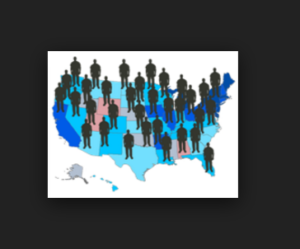Ben and Jerry’s Ice Cream knows a lot about small business loyalty program success. And they pay attention to customer insights for their loyalty program success.

Small business loyalty programs are a great way of showing customers that they are valued. They encourage return business and help you gather information about your customer demographic. Loyalty programs can also boost your marketing efforts.
You can use peer pressure to your advantage from a psychological standpoint by creating social proof.
If you’re unfamiliar, social proof is defined as “the concept that people will conform to the actions of others under the assumption that those actions are reflective of the correct behavior.”
The premise is quite simple. You find ways to prove to potential followers or customers that your brand is awesome.
It follows then that when people see that others are digging your brand, they will feel they should too. Luckily, social media is an ideal medium for creating social proof.
True loyalty is based on emotion. A brand with truly loyal customers doesn’t need to bribe them with mathematically predictable freebies. But, that doesn’t mean programs that reward loyalty are ineffective.
Despite my many bad experiences with United Airlines, I continue to use them to build my Premier status and take advantage of the benefits it confers. (Yes, we can all be bribed into pseudo-loyalty J).
Of course, getting your loyalty program right is critical. According to Inc., it costs a business about 5-10 times more to acquire a new customer than it does to sell to an existing one — and on average those current customers of yours spend 67% more than a new one.
So, what are you doing to keep your customers coming back to your business?
How do you convey enough additional value in your programs to keep your customers coming back? It’s time for marketers to look beyond convoluted rewards systems and offer actual value to customers using their loyalty program.
To get you started, here are some ideas for customer loyalty programs that might work for your small business.
Not a silver bullet
Loyalty programs will not overcome weaknesses such as shoddy products, poor customer service, non-competitive prices, nonintegrated distribution channels, or lack of communication with customers. Instead, think of your program as a part of your integrated customer relationship marketing program — one that helps you to manage the customer life cycle proactively.
Here we use the customer life cycle to refer to the progression rewards structure that would most impact your best customers.
Once you’ve created the loyalty parts of the life cycle where you want to focus, prioritize them to focus on their potential economic impact. Avoid rewarding “free riders” — loyalty members that join your program, but give you nothing in return, and instead focus your efforts on profitable, loyal customers.
Gain customer insights
There’s no better way to determine what will drive customer behavior than to listen to and observe the customer.
Ask your customers what they want, what they like, and dislike. Include customer surveys on your Web site, at point-of-sale, statement, and package inserts. Also, conduct focus groups with your best customers and potentially high-value customers to generate ideas that will enhance the customer experience.
Based on your customers’ feedback, determine the business impact of the requested benefits. Is it financially viable, sustainable and does it ultimately achieve your business objectives?
Build customer relationships
Look at the customer from a holistic perspective and then segment customers that are similar. Create a loyalty profile by ranking your customers by their value to your company, and then differentiate them by their customer lifecycle and needs.
The profile should be a 360-degree view, combining customer relationship elements of purchase behavior, customer attitudes, satisfaction, demographics, and lifestyles.
Set realistic goals and objectives
In general, loyalty programs are often developed with good intentions, but unclear objectives. This can sabotage your program from the start. A program cannot be mass and exclusive, loaded with benefits, and cheap. Take a critical look at your primary business objectives.
Successful program execution is based on working toward a primary business objective.
Small business loyalty program success … social loyalty
Social loyalty leverages the “influencer” factor of social networks. As customers reveal their interests and social behavior by engaging with their friends, family, and colleagues, they become more relevant to businesses. Elements such as emotion and two-way dialogue exist, but they are also the fundamental rules of traditional loyalty marketing.
The unique factor of social loyalty is the way it allows consumers to get together and label themselves with their distinct characteristics in a way that tells companies what they need and what their interests are. Those companies that can provide the correct environment to facilitate interaction, smartly observe and respond in a customized manner.
When investing in extra effort, resources, and money in a subset of customers, make sure they are influencers. More specifically, if you want to send a discount coupon to one of your customers who shopped from your website, see if he has a lot of friends and if he tweets often. If so, get him to share the coupon with them and you will reap the benefits.

Mobile loyalty programs
During the past year, several mobile loyalty programs sprang up to entice small business owners with limited resources to create low-cost programs to reward frequent customers for purchases.
These programs, such as LevelUp, Pirq, and Belly, allow business owners to tailor loyalty programs to their specific business needs. Of course, loyalty programs are nothing new – airlines have awarded miles for years, and retailers like Starbucks continually evolve their in-house programs.
The sudden proliferation of loyalty programs this past year, mainly via mobile apps, is an interesting indicator of what consumers can expect to see more of.
Successful loyalty programs examples … attainable rewards
Any incentive offered within the bounds of a customer loyalty program must be competitive and realistically attainable within a reasonable period. Typically customers expect to earn an award about 6-8 months after joining a program.
By design, a loyalty program is a balancing act between offering some low-cost, easily attainable short-term rewards that can be redeemed early in the program with more highly valued aspirational rewards. Such rewards that can be redeemed later in the program as desired.
While the short-term rewards are used to encourage enrollment and ongoing participation, the aspirational rewards serve as an incentive for your customers to consolidate purchases and award you a greater share of their wallet.
Memorable experiences
While discounts are important to some customers, for much other personal attention and convenience are the factors that create loyalty. Your customers are diverse. Consequently, your program needs to acknowledge these unique customers’ attitudes, behavioral drivers, and needs by responding to their preferences differently.
The better you understand your customers, the better you can push the most appropriate levels for the specific customer. For example, high value, more affluent customers may find personal recognition, special access, and privilege of greater importance.
Customer loyalty program ideas … relevant and consistent
There are more communication channels than ever before.
Depending on your business, customer touchpoints include mail, telephone, fax, text message, e-mail, instant messaging, Internet chat rooms, catalogs, point-of-sale, signage, Web sites, and online bulletin boards.
New forays in Internet-based systems include blogs, video conferencing, podcasts, and meeting-sharing systems. Each touchpoint has its cost implications and perceived benefits to your customer.
In developing your customer communication plan, leverage each touchpoint to reinforce the value proposition and focus on what matters to your customer — creating concise, relevant, and compelling messages that build relationships based on your customers’ needs.
The key to success is to embed your loyalty program into the total customer experience with your company.
Measure success
Customer satisfaction and loyalty metrics should be prominent in performance dashboards and visible to the company’s leadership, including the board. You should measure results in both the short-term and the long-term.
While short-term success is measured by evaluating the results of promotions, events, and customer communication, long-term success is measured by RVF — recency, frequency, and value. Recency is the measurement of when the customer last purchased. It is a good indicator of potential defection.
Frequency is a measure of how often customer shops; it gauges how robust the relationship is between your customer and the company. The value indicates the profitability of the customer; a decline in value can represent a decrease in transaction size and your share of wallet.
Measuring value is more than looking at one transaction; instead, it is a measurement of your customer’s perceived value in the relationship.
Implemented properly, a rewards program can indeed foster true loyalty. If the product is consistently great and the service exceptional, the rewards program can encourage the use and build customer habits. Ultimately, the customer’s affection for the brand becomes more important than the rewards.
The bottom line
Leonardo Da Vinci’s life as a creative thinker provides inspiration and lessons to learn for individuals and companies working in the creative sector. The lessons above have a direct relationship with the design and innovation process inside companies.
Also, they are linked with different creative thinking and problem-solving tools and methods which can be implemented to connect between different patterns to reach creative ideas and solutions.
Do you see? Very, very few of Da Vinci’s abilities are in the populace. But that doesn’t mean you can’t learn to be creative … it can be learned. Can you use these lessons to learn to see or see better? Give it a try. Practice and be persistent. Stick with it, and over the long haul, you will see good dividends.

All you get is what you bring to the fight. And that fight gets better every day you learn and apply new ideas.
When things are not what you want them to be, what’s most important is your next step.
Test. Learn. Improve. Repeat.
Are you devoting enough energy to improve your marketing, branding, and advertising?
Do you have a lesson about making your marketing strategy better you can share with this community? Have any questions or comments to add in the section below?
Mike Schoultz is the founder of Digital Spark Marketing, a digital marketing and customer service agency. With 40 years of business experience, he blogs on topics that relate to improving the performance of your business. Find him on Twitter, and LinkedIn.
Digital Spark Marketing will stretch your thinking and your ability to adapt to change. We also provide some fun and inspiration along the way.
More reading on marketing strategy from Digital Spark Marketing’s Library:
Pinterest Marketing … Rich Pin Tips for Discovery Shopping
Improve Success with Small Business Tagline Designs
How to Get Small Business Press Coverage
9 Critical Factors in Small Business Loyalty Program Success


